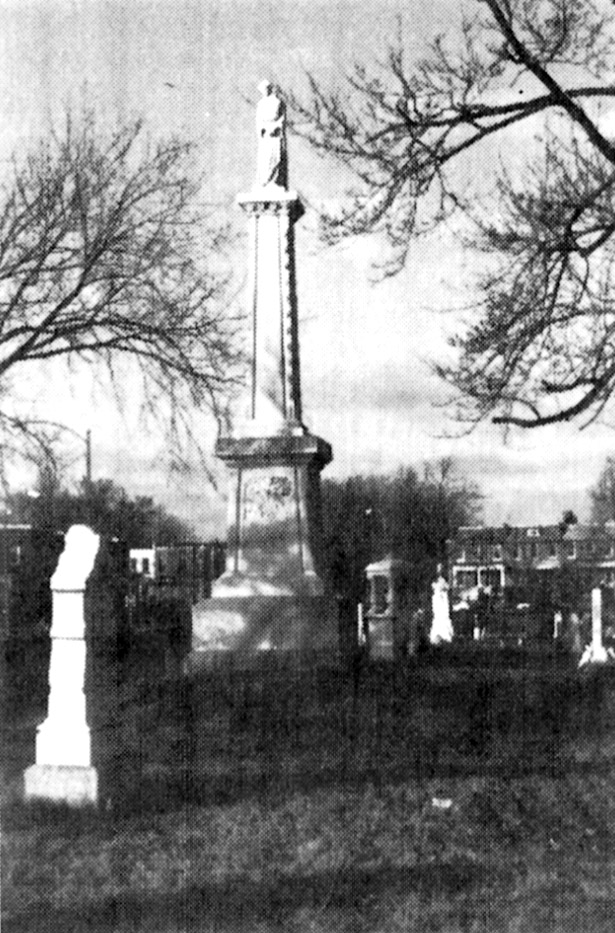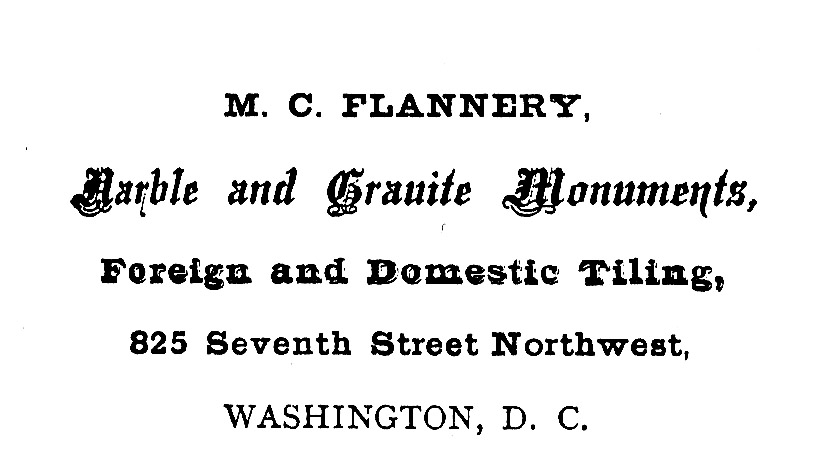Edward Steers, Jr. & Joan L. Chaconas Everlasting in the Hearts of His Countrymen, Abraham Lincoln in the District of Columbia, 1984
The Country's Oldest Memorial to Abraham Lincoln

Lot Flannery's Lincoln. Judiciary Square
The oldest statue of Abraham Lincoln still standing in the United States rests on a modest pedestal in front of the Superior Court of the District of Columbia Building (originally the Old City Hall), located on D Street, between 4th and 5th Streets, N.W., in Judiciary Square.
Located on the front sidewalk leading up to the Superior Court of the District of Columbia is the oldest memorial in the country to Abraham Lincoln. Built in 1820, the present Court House was originally the City Hall and shared its quarters with the District Court. Standing on a rectangular pedestal is the heroic form of President Lincoln, posed as if captured in the middle of delivering a speech, one hand resting on Roman fasces, symbolic of leadership, the other casually open as if to illustrate a pOint.
Frequently identified as the first memorial erected to the assassinated President, the marble statue by Irish-American sculptor Lot Flannery is indeed the oldest memorial still standing, but not the first. Unveiled on April 15, 1868, the heroic marble statue by Flannery was, in fact, the second. The honor of the first memorial to Lincoln belongs to the city of San Francisco, where a life-size plaster statue of Lincoln was unveiled on April 14, 1866, just one year (less one day) after Lincoln's death. A metal replica of the San Francisco statue, substituted in 1889 for the badly eroded original, was destroyed by the great fire of 1906, leaving the Washington statue with the honor of being the country's oldest.


Congressional Cemetery
Lot Flannery together with his brother Martin, owned and operated a tombstone memorial business in the District, and while Flannery did not carve tombstones, his critics often maintained that his style clearly reflected his affiliation with the business. Although one of Flannery's more famous works stands in Congressional Cemetery, he was a bona fide artist and sculptor, and was awarded the commission for his Lincoln following an open competition.
On April 28, 1865, just thirteen days after Lincoln's death, a group of Washington's civic and business 1eadere met in the office of Mayor Richard Wallach and formed the Lincoln National Monument Association. Wallach served as President of the committee with Crosby S. Noyes, owner and publisher of the Washington star, as Secretary, and George W. Riggs, of Riggs Bank, as Treasurer. In an attempt to ensure a national effort in their fund-raising, the committee also included a congressman from each state in the Union. It quickly became apparent, however, that many communities throughout the country had begun their own plans to erect memorials to Lincoln and the Washington committee was forced to limit their efforts to local fund-raising.
For the most part, funds were gathered from many individual residents of the city who considered Lincoln one of their own. The principal contributor, however, turned out to be a former resident who held a close and personal relationship to the events of April 14. He was John T. Ford, owner of Ford's Theatre where Lincoln's assassination took place. Following his sale of the 10th Street Theatre to the government in 1866, Ford continued his business in his home town of Baltimore. On learning of the effort in Washington, Ford held a special benefit performance at his Baltimore Theatre and contributed the proceeds, amounting to $1,800, to the fund, making him the single largest contributor.
On the day of the dedication, April 15, 1868, the newspapers reported that a crowd between 15,000 and 20,000 had gathered for the elaborate unveiling ceremonies. Carpenters had worked all through the previous night, constructing a special platform to hold the 400 dignitaries which included, in addition to the committee, President Andrew Johnson, the sculptor Lot Flannery, and orator of the day, Brevet Major-General Benjamin B. French. Absent among the host of dignitaries were members of the House of Representatives and Senate, and members of the Supreme Court who respectfully declined invitations, due to the pressing business of the day - the impeachment trial of President Johnson.
Also absenting himself from the speaker's stand that day was the nation's hero and soon-to-be eighteenth President, Ulysses S. Grant. Grant, whose feud with Johnson stemmed from his disappointing experience as Secretary of War, chose to stand on the sidewalk with his fellow countrymen, rather than share a spot on the special stand with Johnson, whom he now bitterly opposed.
The bands played and the orators spoke. The main speaker was B.B. French. French had a long career as an effective administrator with the Army and had been a close personal friend of Lincoln. During the Civil War, he served as Commissioner of Public Buildings and wrote and delivered the Ode at Gettysburg commemorating the National Cemetery there on November 19, 186;. As the ceremonies came to a close, President Johnson pulled the cord, causing the veil to fall from the monument to the loud cheers of the assembled spectators. With its unveiling and acceptance by the people who had paid for its creation, the Flannery statue of Lincoln gazed from its forty-foot high column over the Nation's Capital.
Flannery claimed he had placed Lincoln high enough so that no assassin's hand could ever again strike him down. But, if Flannery had securely elevated Lincoln above the assassin's hand, he forgot about the politician's. In 1919, 51 years after the dedication, Lincoln was struck down a second time. During plans to renovate the Old City Hall for its centennial in 1920, the statue of Lincoln was taken down, clearly with the intention of never being returned to its original spot in front of the City Hall.
As word of the silent removal spread across the country, outrage began to swell among northern patriotic organizations. Soon the Congress, in a scramble to redeem itself from the slander of national outrage, rushed to vote sufficient funds to re-erect Flannery's Lincoln and return the work to its rightful place. When the time came to put the statue back, however, it could not be found in the Old City Hall where it was supposed to have been safely stored - it was missing! What John Wilkes Booth and his band of conspirators could not do, unknown persons apparently had - the successful abduction of Abraham Lincoln.
Thanks to the anger and persistence of an old friend of Lot Flannery and Abraham Lincoln, the statue was finally located and returned. Freeman Thorp, a portrait artist of some note, searched for the missing statue and found it lying partially crated on the mud flats near the Potomac River, behind the Bureau of Printing and Engraving. After a thorough cleaning, the statue was placed on its present pedestal and ceremoniously rededicated on April 15, 1923, peaceful at last - or so we hope!

Download PDF